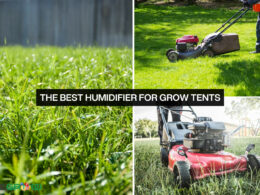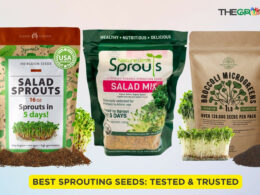In This Article Show
Choosing the best fertilizer for Nandinas is essential to ensuring their health, growth, and overall beauty. We understand that finding the perfect fertilizer can be overwhelming; hence, we have compiled seven fertilizers to help you achieve the desired results with your Nandinas plants.
| Image | Product | Features | Price |
|---|---|---|---|
 | 9.9 | Check Price | |
 | Jobe’S Plant Food Azalea , Camellias & Rhododenron Fertilizer | 9.8 | Check Price |
 | 9.7 | Check Price | |
 | 9.6 | Check Price | |
 | Jobe’s Organics 09526 Organic All Purpose Granular Fertilizer Get Gardening For Beginners Our new EBOOK shows newcomers and green thumbs alike a step by step guide to growing the garden of their dreams. | 9.5 | Check Price |
 | 9.4 | Check Price | |
 | Neptune’s Harvest Organic Hydrolized Fish & Seaweed Fertilizer
| 9.3 | Check Price |
The Nandinas, also known as heavenly bamboo, is a beautiful plant that is often used for decorative purposes. Although referred to as bamboo, it isn’t bamboo at all. It is a species of flowering shrub that originates from eastern Asia.
We love the heavenly bamboo because of the touch of elegance it adds to any garden or landscape. Although nandinas is a low-maintenance plant, it requires fertilizing to stay healthy and lush through the season.
Why Fertilization is Crucial for Nandinas
As someone who has spent over a decade nurturing gardens, I’ve learned that understanding the role of fertilizers is key to ensuring plant health and growth, especially for Nandinas.
These plants, while resilient, thrive best when given the nutrients they need. Here’s why fertilization is an essential part of caring for your Nandinas:
The Role of Fertilizers in Plant Health and Growth
- Essential Nutrient Supply: like all plants, Nandinas require a balance of essential nutrients to grow. Fertilizers provide these nutrients, particularly nitrogen, phosphorus, and potassium, which are not always sufficiently available in soil.
- Enhanced Growth: Proper fertilization leads to stronger, more vigorous growth. For Nandinas, this means lush, vibrant foliage and, for flowering varieties, more abundant blooms.
- Improved Plant Resilience: Well-fertilized plants are generally healthier and more capable of withstanding environmental stresses, pests, and diseases.
- Soil Health Maintenance: Regular fertilization helps maintain soil health over time, ensuring a fertile environment for Nandinas and other garden plants.
Signs of Nutrient Deficiencies in Nandinas
Recognizing nutrient deficiencies early can prevent long-term damage. Here are some signs to look out for in your Nandinas:
Get Gardening For Beginners
Our new EBOOK shows newcomers and green thumbs alike a step by step guide to growing the garden of their dreams.
- Yellowing Leaves: If the leaves are turning yellow, particularly starting with older leaves, it could be a sign of nitrogen deficiency.
- Stunted Growth or Weak Stems: This may indicate a lack of phosphorus, vital for energy transfer and growth.
- Older Leaf Edges Turning Brown or Curling: This can be a symptom of potassium deficiency, which is crucial for water regulation and overall plant health.
- Poor Flowering or Fruit Production: A lack of essential nutrients can lead to reduced or poor-quality blooms and berries in Nandinas.
The Best Fertilizers For Nandinas
It is no mistake that Dr. Earth Organic Fertilizer is first on our list. This fertilizer is loved because it is the only NON-GMO verified fertilizer in the USA. This means it is made with no synthetic chemicals or genetic engineering, making it a highly natural and safe food for your plant.
It isn’t just safe for your plants, humans, and pets. Dr. Earth’s fertilizer is made with ingredients that your nandinas require and the micronutrients you need to keep your plant healthy.
Proteins, carbohydrates, multi-minerals, etc. It keeps your plant colorful throughout the season and revives dying plants. To apply this fertilizer, add it directly to the plan and then water it. It is however considered expensive, you may also need to buy more from time to time.
Jobe Organic fertilizer is a specially formulated fertilizer, especially for acid-loving plants. Although Nandinas is a mild-acid lover, Jobe’s organic fertilizer will still give give you and your plant the result you need. This fertilizer gives plants the nutrients they need to bloom and thrive.
It works by first improving the soil environment for the plant, and this is good as it increases the uptake of these nutrients by the plant, it supplies nutrients from below the surface, and the active roots can get it the most.
We love that this fertilizer is a certified organic product; hence, no synthetic chemical was used to produce it. Jobe’s Organic fertilizer is easy to use, all you need to do is sprinkle the fertilizer in the right place, into the soil, then thoroughly water the location that has been fertilized.
Oscomote plant food is a slow-release plant food known and loved by many. We love that Oscomote contains the essential nutrients that nandinas need to grow and bloom, including other micronutrients, they may require.
As this is a slow-releasing fertilizer, it continues to feed and supply the required nutrients for up to 6 months. This fertilizer is ideal for container-grown nandinas. We love that Oscomote guarantees that your plant will not get burnt, even if you apply the product 3 times its recommended rate.
However, you must stick to the recommended application description. It is said to work best when mixed into 1 – 3 inches of soil. For container plants, you should mix one pound with 19 gallons of potting soil.
Fish fertilizers are one of the ways to feed your plants organic food. Alaska fish fertilizer is one of the best fish fertilizers you can feed your plants with. It is a fish emulsion fertilizer and is obtained from a mix of seagoing Alaskan fish. With this fertilizer, you have a guarantee that your plants are feeding on pure and organic materials.
Not only is it organic, but it is also a slow-releasing fertilizer, which ensures that your plant gets nutrients through the season. It contains all the essential nutrients your plant needs to grow healthily and stay beautiful. It is perfect for indoor and outdoor plants, ranging from vegetables, fruits, roses, and shrubs such as the Nandinas.
We also love that it is odor-free, hence you do not have to worry about pests attracted by smells. You may need to exercise some caution as applying too much of this product on your plant can result in burns for your plant and affect its growth. To apply, mix it with a gallon of water, then spray the mixture on the leaves of your plant.
Fertilizers from Jobe’s are one to love and the reason isn’t far-fetched. This product is designed to work for different types of plant species; ranging from flowers, vegetables, trees, plants, and shrubs, hence it can be used for your precious nandinas as well. It is also certified as a product made with zero synthetic chemicals.
We especially love that it is specially designed to feed nandinas at the root level, where active growth takes place. It is a slow-release fertilizer, ensuring that your elegant plant is nourished all season long, resulting in its beautiful flowers and strong roots. It is easy to apply and begins to show results in no time.
Although the Fox farm fertilizer is designed for Japanese maples, it is also very beneficial for nandinas. This fertilizer comes in a granular form and is made with organic products alone.
As a result of the natural products present in this fertilizer, it also contains essential nutrients that the nandinas need to grow healthy, produce colorful leaves, and strengthen the plant’s overall health. It also contains humic acid which allows the plant to absorb micronutrients.
Neptune’s harvest organic fish and seaweed fertilizer is an excellent fertilizer, that will not only keep your plant blooming through the season but also improve its overall health.
The combination of fish and seaweed guarantees the organic authenticity of the fertilizer. The nutrients obtained from the combined main products, enhance nandinas’ resilience, promote nutrient uptake, and increase resistance to stressors.
How and When to Fertilize Nandinas
In my years of gardening, I’ve learned that timing, frequency, and method are key when it comes to fertilizing plants, especially Nandinas. Here’s a straightforward guide to ensure you’re providing the best care for these beautiful shrubs:
Best Practices for Fertilizing Nandinas
Timing is Everything
The best time to fertilize Nandinas is in early spring as they begin to grow actively and again in mid-summer to support continued growth. Avoid fertilizing late in the season, as this can stimulate new growth that may not harden off before winter.
Frequency Matters
Generally, fertilizing twice a year – once in spring and again in summer – is sufficient. Over-fertilizing can be as harmful as under-fertilizing, leading to excessive growth and potential damage to the plant.
Application Methods
Granular Fertilizers
Apply around the base of the plant, extending to the drip line (the area directly under the furthest reach of the branches). Follow this with a thorough watering to help the nutrients seep into the soil.
Liquid Fertilizers
Dilute as directed and apply to the soil at the base of the plant. These are absorbed more quickly and may need to be applied more frequently.
Seasonal Fertilization Tips
- Spring: Use a balanced fertilizer (like a 10-10-10 NPK ratio) to support overall growth. This is the time for Nandinas to build up their strength for the growing season.
- Summer: A light application of fertilizer can help sustain growth, especially if the plant is not performing as well as expected.
- Fall and Winter: Avoid fertilizing in these seasons. Nandinas, being semi-evergreen, will slow down their growth, and new growth spurred by late fertilizing can be damaged by cold weather.
Remember, Nandinas are relatively low-maintenance plants. Over-fertilization can lead to lush foliage at the expense of flowers and berries, so it’s important to strike the right balance.
Common Mistakes to Avoid in Fertilizing Nandinas
Over the years, I’ve seen a few common mistakes gardeners make when fertilizing Nandinas. Being aware of these pitfalls can help you avoid unintentional harm to these plants:
Over-Fertilization and Its Effects
- Excessive Growth at the Expense of Flowers: Too much fertilizer, especially high-nitrogen formulas, can lead to lush, green growth but few flowers or berries. The beauty of Nandinas partly lies in their colorful berries and flowers, so balance is key.
- Root Burn and Plant Stress: Over-fertilizing can cause a buildup of salts in the soil, leading to root burn. This stress can make Nandinas more susceptible to disease and weather damage.
- Environmental Harm: Excess nutrients can leach into the groundwater, causing environmental issues. It’s essential to use fertilizers responsibly to avoid such impacts.
Incorrect Application Methods
- Applying Too Close to the Base: Fertilizer applied directly against the stem or trunk can harm the plant. It’s best to apply fertilizer starting a few inches away from the base and extending to the drip line.
- Not Watering After Application: Fertilizers need to be watered into the soil to be effective. Failing to water after applying a granular fertilizer can lead to nutrient wastage or uneven absorption.
- Ignoring Soil pH and Composition: Nandinas prefer slightly acidic to neutral soil. Ignoring soil conditions when choosing a fertilizer can lead to poor plant health. A soil test can be a helpful guide in this regard.
General Tip 💡
Always follow the manufacturer’s instructions on the fertilizer packaging. These guidelines are designed to ensure you use the product safely and effectively.
Frequently Asked Questions
What kind of fertilizer is best for Nandinas?
Nandinas benefit from a balanced, slow-release fertilizer with an equal nitrogen-phosphorus-potassium (NPK) ratio of 10-10-10. This type of fertilizer provides a steady supply of nutrients without overwhelming the plant.
How often should I fertilize my Nandinas?
Twice a year is usually sufficient – once in early spring as new growth appears and again in mid-summer. It’s important not to overdo it, as excessive fertilization can lead to problems.
Can I use organic fertilizers for Nandinas?
Absolutely! Organic fertilizers like compost or well-rotted manure can be excellent for Nandinas. They not only provide nutrients but also improve soil structure and health.
How can I tell if I’m over-fertilizing my Nandinas?
Signs of over-fertilization include yellowing or browning leaf tips, wilting, and a general decline in plant health. If you notice these symptoms, hold back on fertilizing and ensure the plant is adequately watered.
Do Nandinas need special fertilizer?
While specialized Nandina fertilizers are available, they are not strictly necessary. A general-purpose, balanced fertilizer is usually adequate for their needs.
Should I fertilize Nandinas in the fall or winter?
It’s best to avoid fertilizing Nandinas in the fall and winter. Fertilizing during these seasons can stimulate new growth that is susceptible to frost damage.
Can I use the same fertilizer for Nandinas and other plants?
Yes, a general-purpose fertilizer suitable for Nandinas can often be used for other plants in your garden. Just be sure to consider the specific needs of each plant.
Final Thoughts
Picking the right fertilizer for your nandinas is essential to their overall health, beauty, and vigor.
The above-referenced products will provide your nandinas with the growth and elegance you need. You must apply the products as instructed by the manufacturers; this will guarantee the results that you need.










